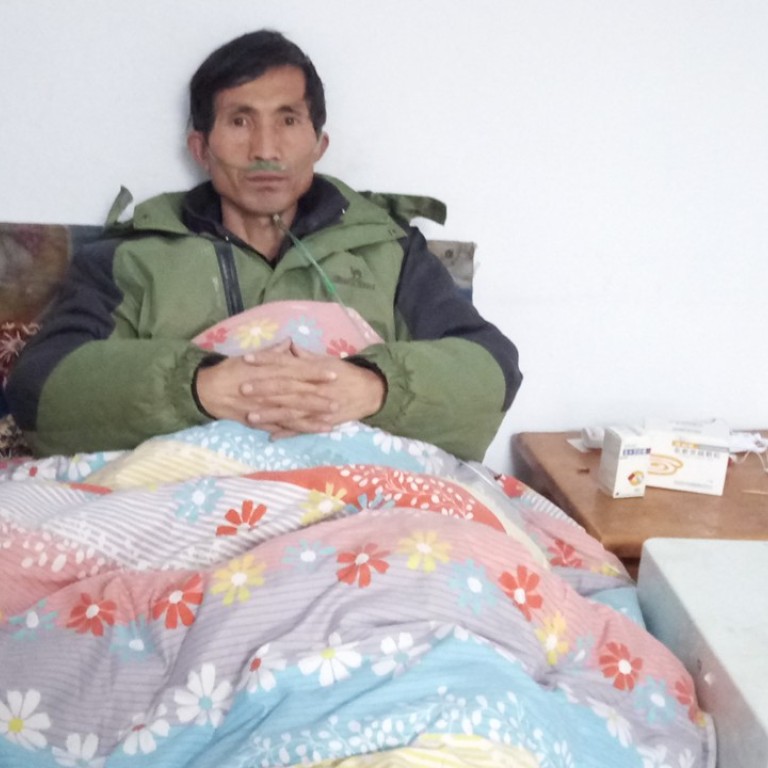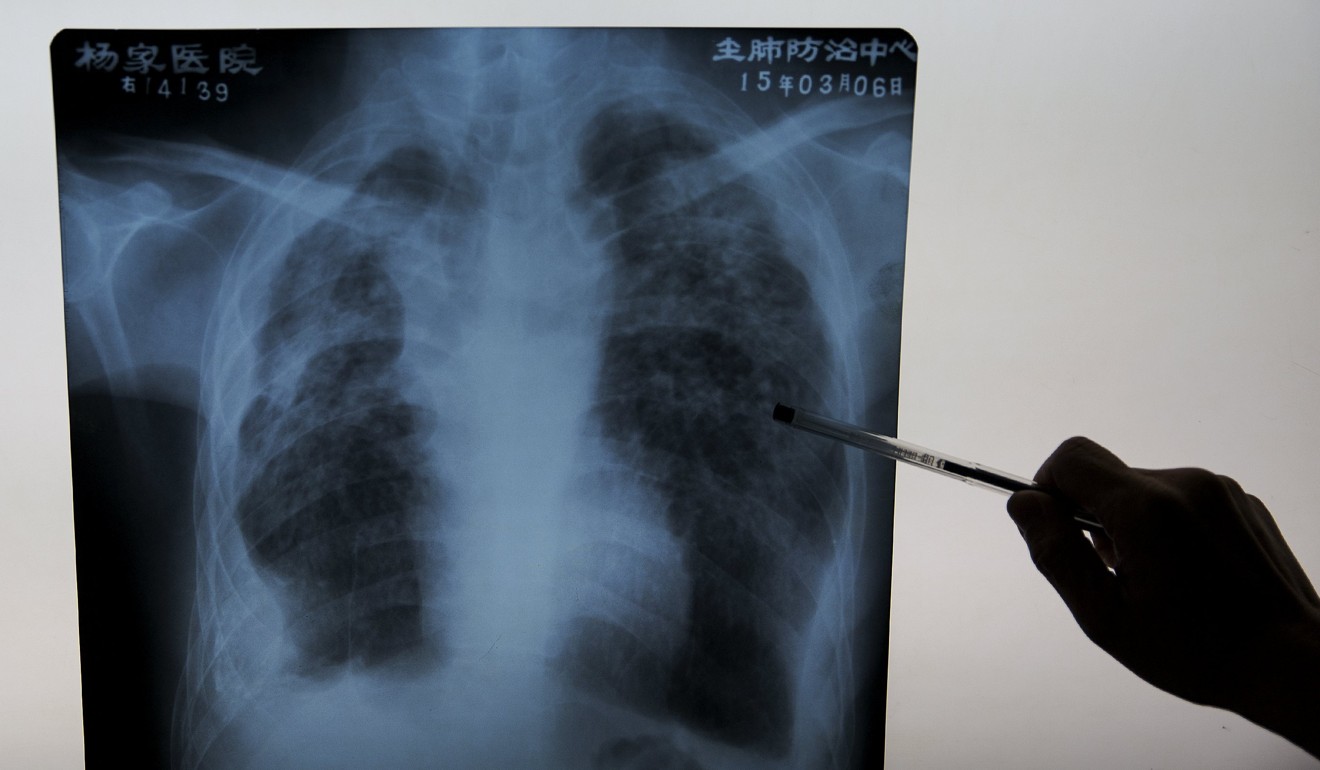
These migrant workers helped China prosper. Now they’re dying and not getting the help they need
China is home to an estimated six million people with pneumoconiosis and many of them are still struggling two years after government ordered action
Ningxia farmer Liu Yanping has had to breathe with the help of an oxygen generator for the past three years.
Now 56, he used to work at a small brick kiln and the coal dust he inhaled over the years scarred his lungs, severely restricting the amount of air they could take in.
Three years ago, at a hospital in Yinchuan, the regional capital, he was diagnosed with pneumoconiosis, an incurable disease caused by long exposure to industrial dust.
It is the most serious and most common occupational illness in China, but the plight of migrant workers suffering from it – after helping to power China’s economic boom – only received central government attention two years ago, when 10 government departments jointly issued a circular ordering local governments to step up prevention and treatment.
Some of the victims say they have yet to see much help at the grass roots.
How the eviction of Beijing’s migrant workers is tearing at the fabric of the city’s economy
Liu Yanping’s son, Liu Zezhao, who lives in a village in Ningxia’s Tongxin county, said the family had barely received any help from the authorities, with government reimbursement only covering 10 per cent of his father’s medical bills.
“We are poverty-stricken after spending over 600,000 yuan (US$92,000) on my father’s disease,” he said. “I borrowed money from relatives, friends and loan sharks and I also sold the flat I bought in the town years ago.”
His father, lured by the relatively high pay, worked at a brick kiln about 2.5km (1.5 miles) from the village from 1998 to 2011, smashing chunks of coal into powder. He earned about 600 yuan a month around the turn of the century.
The kiln’s boss refused to give him any compensation because he had never signed an employment contract, something that is common among China’s migrant workers.

The kiln was still operating, Liu Zezhao said, and no action had been taken against its owner even though six workers from the village had developed pneumoconiosis – five of whom had died.
I think he’s suffering from suffocation and it can last for more than 10 minutes. It’s miserable and I burst into tears seeing my father in such pain
He said the family was so poor that they lived in a house built of mud. However, village officials had turned down their application for financial aid multiple times.
He put their refusal down to his failure to offer them bribes. “Corruption among the grass-roots authorities is beyond your imagination,” he said.
His father’s health had deteriorated recently, he said, with “horrific breakouts” occurring about 10 times a day.
“Suddenly, when my father is talking with me normally, he can’t breathe,” he said. “His face swells up, his eyes bulge and his head sweats heavily. He also grabs madly at things.
“I think he’s suffering from suffocation and it can last for more than 10 minutes. It’s miserable and I burst into tears seeing my father in such pain.”
There are about six million pneumoconiosis victims on the mainland, according to an estimate by an NGO, the Love Save Pneumoconiosis Foundation. Its estimate is nine times the Ministry of Health’s official tally.
The ministry said there were 676,541 people diagnosed with pneumoconiosis living in mainland China at the end of 2010, accounting for 90 per cent of all cases of occupational illness. According to more recent figures from the ministry, there were 26,081 new cases of pneumoconiosis reported around China in 2015, and 28,088 in 2016.
China holds outdoor trial of migrant workers protesting unpaid wages ‘to educate public in law’
“The approximate number of six million is based on our surveys across the country over many years,” foundation secretary general Guo Xiaoye said. It is one of the biggest NGOs seeking to help pneumoconiosis patients in China, most of whom are migrant workers from rural areas, and was also one of the earliest to get involved in their plight.
“The government’s statistics mainly cover workers at state-owned enterprises. But the majority of migrant workers work at privately run mines. Although they got pneumoconiosis from their work, they cannot be recognised as occupational disease victims since the identification process is complicated.”
The circular issued by the central government departments in January 2016 said migrant workers made up the bulk of China’s industrial workers.

“By the end of 2014, there were 274 million migrant workers in China,” it said. “They are an important force boosting the country’s construction and they have contributed tremendously to economic and social development.”
However, it went on, because some enterprises had been derelict in their duty to prevent occupational diseases, and because migrant workers lacked awareness about protecting themselves at work and safeguarding their rights, pneumoconiosis continued to be a problem. It said the disease was not diagnosed in a timely manner and the problems faced by victims in seeking treatment and compensation had not been solved.
Enterprises were ordered to shoulder the responsibility of preventing the disease through dust management at work places, while medical institutions were told to be more efficient in diagnosing the disease and identifying it as an occupational illness.
Local authorities were also required to deal with migrant worker’s medical costs and livelihood problems, including those who were not part of the industrial injury insurance scheme and those whose employers could not be traced.
In China, losing battle against lung disease and workers' rights
However, Guo said, the implementation of the orders differed from region to region.
“There are still many migrant workers who cannot get proper compensation from their employers or aid from the authorities,” she said. “We see countless cases of families falling into destitution because of this disease.”
We see countless cases of families falling into destitution because of this disease
Very few workers ended up taking their employers to court because many bosses fled after shutting down the workplaces, Guo said, and, being poorly educated, they knew little about protecting their rights.
“Many of them got the lung problem and just returned home, blaming their woes on bad luck,” she said.
Zhang Yuanjun, a 43-year-old farmer and migrant worker from Jiyuan in Henan, was among those who opted for litigation, along with 42 fellow workers at a private coal mine.
They had not signed contracts, but the local court recognised their employment relationship with the mine, meaning they could demand compensation from it.
“But the mine boss deliberately postponed the lawsuit, hoping we would die off one by one so that he could pay less compensation,” Zhang said.
The workers also tried to petition the city, provincial and central authorities, but were either chased away by government officials or beaten by thugs hired by the mine, he said.

Zhang, who worked at the mine for 16 years from 1990, is now a stage III pneumoconiosis patient – the most serious stage of the disease.
“After graduation from junior middle school at the age of 16, I went along with hundreds of people from my village to work at the nearby mine,” he said. “We were paid more than a civil servant. It was attractive at that time.”
They had never heard of pneumoconiosis and were unaware of the dangers of dust. Inside the mine, he said, the coal dust was so thick that workers could not see light bulbs or their own fingers.
“Some of us would buy a mask to wear, but it was not useful,” he said. “After being used for a day, the mask became black.”
Wu Dengfan, a 40-year-old farmer from Gulang county in Gansu who worked at a gold mine close to the Mongolian border from 1996 to 2006, had a similar experience.
“We even preferred not to wear masks inside the mine, because it made breathing even more difficult,” said Wu, who has stage II pneumoconiosis. “When we finished our work and came out of the mine, each of us was completely covered in dust.”
Lung disease kills far more miners than accidents do
He receives a combined 2,100 yuan a month from the gold mine and the county government thanks to a petition filed by more than 100 workers at the mine several years ago.
It’s such a cruel reality. We worked at mines, factories and construction sites and we made our contribution to society’s prosperity
“It’s OK to support our basic living requirement. But if my situation gets worse it’s not enough to cover expensive medicines,” he said. “I can’t do any labouring work and can’t earn money. My wife has rheumatism and our two children, one 13 and one 10, will need more money for their studies. I am really worried about the future.”
Zhang, who is also a volunteer at the NGO, said he chatted on social media with patients or their relatives every night, offering advice on treatment or psychological comfort.
“It’s important to vent the pressure in our hearts,” he said. “Each year I hear of several migrant workers committing suicide by jumping from a high building or taking poison. Many workers’ wives leave them once they are diagnosed with this disease.
“It’s such a cruel reality. We worked at mines, factories and construction sites and we made our contribution to society’s prosperity.
“But we earned the money at the cost of not only our labour, but also our health and life. The governments kick us between themselves, like a ball, and no department is really serious about our plight.”

